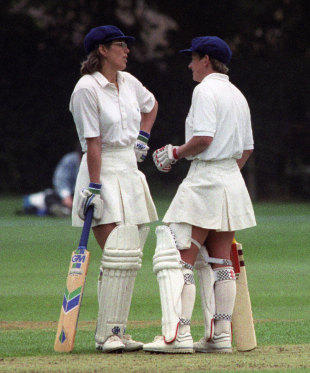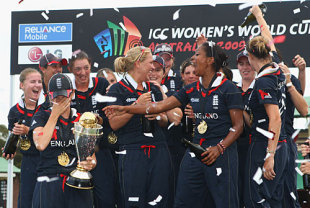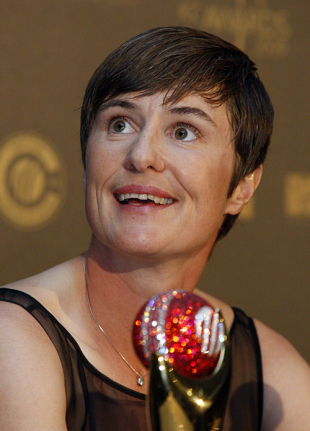From culottes to contracts
Claire Taylor

|
|||
|
Related Links
Players/Officials:
Claire Taylor
| Clare Taylor
Teams:
England
|
|||
In 1993 - two decades after they first achieved the feat - the England women's team won the World Cup, beating New Zealand in the final at Lord's. I was there that day, sitting high in the Grand Stand among a crowd of 5000, a bespectacled teenager in a floppy hat, watching my heroes achieve their dream.
Fast forward 16 years, and England were back at Lord's, beating New Zealand once more, this time in the final of the World Twenty20. I was lucky enough to hit the winning runs. Four or five times as many witnessed that victory and, though there was no pitch invasion, the players did enjoy a lap of honour.
The game I finally left last year felt like a different world from the one I watched at Lord's 18 years earlier. The 1993 squad was, on average, three years older, and had jobs outside cricket. Players wore white culottes and long socks - not quite the blue and red ribbons used to distinguish the "11 maids" of Bramley and Hambledon who earned a mention in the Reading Mercury in 1745, but not exactly the attire you might associate with an athletic game. They bought their own royal-blue blazers and sewed on the Women's Cricket Association badge. They took unpaid leave from work to go on tour and, in some cases, there was no job waiting for them when they got home. It was a labour of love, spirited but precarious.
This is in no way to diminish the skill of those players. That day at Lord's I was thrilled to witness Jo Chamberlain's all-round aggression, an amazing catch in the gully by Suzie Kitson, and Jan Brittin's silky batting. In general, though, that skill was not coached or drilled: it was natural and exuberant. If the players thrived, it was in spite of the set-up, not because of it.
Today's cricketers are younger. They are semi-professional athletes, training five or six times a week, travelling to England sessions in Birmingham or Loughborough. They work with individual batting, fielding and bowling coaches, and there is a network of physios, doctors and other sports scientists. Players are given work within the game and supported financially. Much is expected of them - more than in 1993. It's fair to say my career spanned two very different eras.
Women's cricket has come a long way since it was formalised by the emergence of the Women's Cricket Association in 1926 in Colwall, Malvern. Women played the game as amateurs, and it was run by volunteers. Alan Lee wrote in the Times that the 1993 final "illustrated the athleticism of the game and the status to which it can aspire; what is needed now is firmer and more enterprising administration".
The WCA had put all their effort into hosting that tournament, sourcing last-minute grants from the Foundation for Sport and the Arts to ensure it wasn't cancelled days before the start. Once the celebrations had died down and appearances on A Question of Sport had been made, it became clear the WCA was neither financially nor structurally capable of exploiting the surge in interest.
Momentum was lost, and it was not until 1997 that women's cricket acquired its first manifestation of professionalism: sponsored by Vodafone, the team appeared in trousers for the first time. At long last, international cricketers were able to dive for the ball - and the crease - without worrying about the skin on their knees. It was a wonder this basic courtesy had taken so long.
A year later, the WCA were officially enveloped within the ECB, and it was in that environment that I played my first game for England, coming into the squad as reserve wicketkeeper to the imposing Jane Smit after a successful trip to South Africa with the Under-21s. My debut against Australia at the old Northlands Road ground in Southampton involved six English run-outs, though I wasn't in long enough to feature in any: out for one from 14 balls. That Australian team was full of hard players who gave no quarter and were never going to allow a youngster like me an easy start.
When I began working with Mark Lane later in 1998, I became one of the first players to develop a long-term coaching relationship with a figure outside the England set-up. Until then, most coaching for senior players was through England camps or perhaps ten minutes with an elder and better at club or county nets. My work with Mark, who would go on to coach the national side, was self-funded then. It was to be the start of a 13-year alliance which helped to transform me from average to world-class.
I had finished university in 1997, collecting a maths degree from Oxford, and started work with Procter & Gamble in January 1998. I was balancing my burgeoning cricket career with a graduate job, travelling to Europe once a week on average, in the office before seven every other morning so I could escape to the gym or the Surrey Cricket Centre at Guildford by five. Every Friday during the long winter months, I would make my way to the indoor nets at The Oval, train with male club cricketers, then head back - exhausted but exhilarated - to South London suburbia.
Friction between my two employers came to a head in 2000, when there were 14 weeks of international competition in the calendar. The ECB supported us by offering tour fees, but my issue was lack of holiday time rather than finances. "Seven weeks of National Service" was how we got around it - unpaid leave akin to that given to those in the Territorial Army. But I was being asked serious questions about my commitment to P&G. Eventually, I secured redundancy and said hello to life as a semi-professional cricketer.

|
|||
Similar progress had been made in other areas - small triumphs, perhaps, but long overdue. In 1998, Belinda Clark was named Cricketer of the Year by Wisden Australia, while Isabelle Duncan, a club player from Surrey, made the front cover of Wisden Cricket Monthly, wearing an MCC sweater. Soon after that, the club finally threw its doors open to women members - well, ten of them, anyway. Plenty of us noted all this with quiet satisfaction.
Meanwhile, the merger with the ECB had increased the profile of the women's game: applicants for coaching roles included the likes of Paul Farbrace and Graham Dilley, who both took the squad to Australia and New Zealand in 2000. They brought drills and attitudes from the men's game, and their expectations of players were higher.
All this required extra commitment from the women, which in turn was rewarded by the availability of Sport England funding. Elite female cricketers were now treated in the same way as their netball or rowing counterparts. We had funding to cover most of our costs, and a low-level subsistence grant to provide some recompense for the time we had to take off work to train.
We received support in other areas too: strength and conditioning, physiotherapy, medical, lifestyle and nutrition - assistance that male cricketers on county contracts took for granted. England's women were now in the enviable position of working with the best in the business at a local venue. Coaches set our gym programmes and would go through sessions with us once a week to check technique.
We were now training alongside Olympic athletes: sprinters, rowers, weightlifters. The physical comparisons may not have been favourable to start with, but improvements have been significant. Players learned Olympic lifting patterns, progressing from the bar to perhaps cleaning their own body weight. This made us quicker, more agile and more resilient. It helped me hit the ball harder and increase my throwing range.
Players started to travel overseas in 2001, with Clare Taylor - the Huddersfield-born seamer - and Charlotte Edwards playing domestic cricket in New Zealand. I spent three winters in Christchurch for Canterbury before joining England wherever they were in the world. Clare was a classic beneficiary of the new arrangement. An excellent footballer who represented Liverpool Ladies, as well as England at the 1995 World Cup in Sweden, she would previously have spent her winters alternating between the two sports. Now we toured every winter.
This commitment was starting to pay off, but we were still a long way short of the powerhouses: India, New Zealand and, of course, Australia. We failed to make the last four in the 2000 World Cup, then lost on a Potchefstroom greentop against Australia in the 2005 semi-final.
More work was needed, and we were helped by the introduction of the Super Fours competition. The WCA had run a territorial tournament in August each year, but this faded away after 1994, only to be reborn eight years later. Super Fours pitted the best 48 cricketers in the country against each other on a more regular basis, gave the selectors a focal point and provided the players with competitive experience.
The emergence of Twenty20 was equally crucial, and our game against New Zealand at Hove in 2004 was the first in the format at international level. The benefits were obvious. Bowlers required control, variation and mental toughness. Batters needed to be less predictable, to hit the ball harder, into gaps or over the infield, and to run hard between the wickets. Fielders needed to be agile and proficient in different positions.
We started competing against boys' teams, which tested us against players who could bowl faster, strike harder and throw further than us. The boys would get frustrated by our control, and would react with brawn rather than brain; it was our greater tactical awareness against their greater physical presence. We were moving in the right direction. World domination became our mantra.
Off the field, however, things were getting more difficult. Scheduling training, physiotherapy and coaching with practitioners who worked from nine to five meant our training became a nine-to-five activity too, which put more pressure on those trying to play alongside a normal job. A survey of player commitment in 2007 led to a call for a change in the way the women were funded. We were giving around 70% of the equivalent of a full-time job to cricket. It became impossible to play for England and still work full-time for another employer. Something had to change.
The ECB met the challenge by creating the Chance to Shine Coaching Ambassador scheme with the help of the Cricket Foundation. The Chance to Shine contracts offered us work that was within the game so we could give something back. It gave us a means of earning a living in a part-time job. And it gave the ECB ready-made role models in schools and clubs.
Everything came together in 2009 with victories in the 50-over World Cup in Australia, and that unforgettable day against New Zealand at Lord's. Results fluctuated in the immediate aftermath, as players went back to work or concentrated on their education. But the squad reconvened for a quadrangular competition in the summer of 2011, which involved 50-over and Twenty20 matches against Australia, New Zealand and India. We retained our World No. 1 status in 50-over cricket and won the Twenty20 competition too. I retired at the end of the tournament, but was delighted to see the team winning one-day and Twenty20 series in South Africa in October.
I felt I could leave happy to have achieved most of what I hoped for. England are back at the top of the tree, and the squad is full of youngsters with natural talent, a taste for hard work and ambition. The women's game is in a good state, but there is still room for improvement.
Those who come to watch are impressed by the skills of the players, their athleticism and their evident love of cricket. Attitudes towards women's cricket are improving, but there are still those we need to convert. More television coverage and more adventurous marketing might tempt these folk to come along. When women compete against women, the physical comparison with men becomes irrelevant. Women's cricket is a skilful game, attractive in its own right.

|
|||
But the fact is, there remains a frustratingly hard-to-break shackle of male dominance in the sporting press. Other than my inclusion as a Wisden Cricketer of the Year in 2009 and reactions to our world dominance that year, there has been little written media coverage. Journalism extends as far as the replication of ECB press releases on websites, and there are precious few column inches in the sports sections. What hope have we got of attracting new fans when some newspapers don't even print full scorecards of our matches?
We were especially hurt by the BBC's Sports Personality of the Year awards in 2009. We were double world champions, Ashes winners, had whitewashed Australia and arguably had five players in a hypothetical team of the year. Yet the men's side won instead, their Ashes triumph prevailing over poor performances in the World Twenty20 and a one-day thrashing by Australia.
It would help, perhaps, if there was more competition at international level. The ICC took over the women's game in 2005 and ran their first World Cup in Australia in 2009. I hope this heralds a large number of new international teams. It may take some time, but it can only improve the state of the sport at the highest level.
Within the domestic game, we need a greater number of mature players. Progress has been made across the gamut of youth cricket; this now needs to be matched by the retention of those players. Those in their mid-twenties will become our club volunteers, youth coaches, and social organisers. They will keep the clubs alive to provide opportunities for tomorrow's England stars.
In October 2011, the ECB took another step forward with the reappearance of tour fees and introduction of match fees. This probably makes England's cricketers the best-funded female team-sport athletes in the country, and takes them into a truly professional era. The players now bear even greater responsibility: to ensure that the values of the game are upheld; to continue to apply the principles behind our recent successes; and, as individuals, to hold the game in the highest regard for all it gives them.
Claire Taylor scored 5746 runs for England in 15 Tests, 126 one-day internationals and 27 Twenty20 internationals. She was the first woman to be named a Wisden Cricketer of the Year, in 2009

